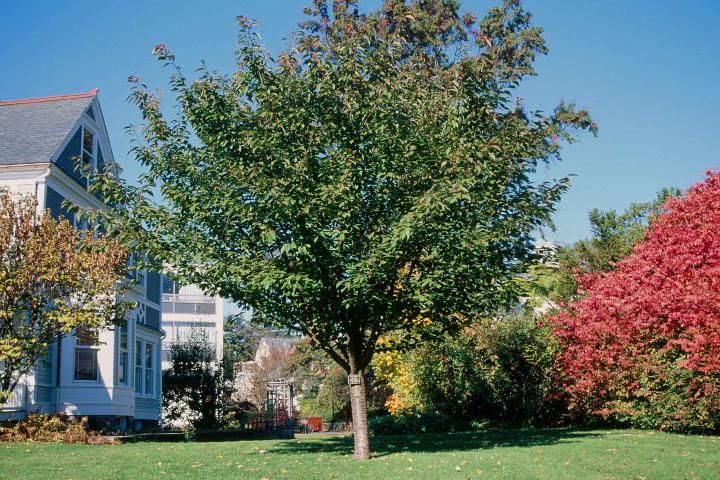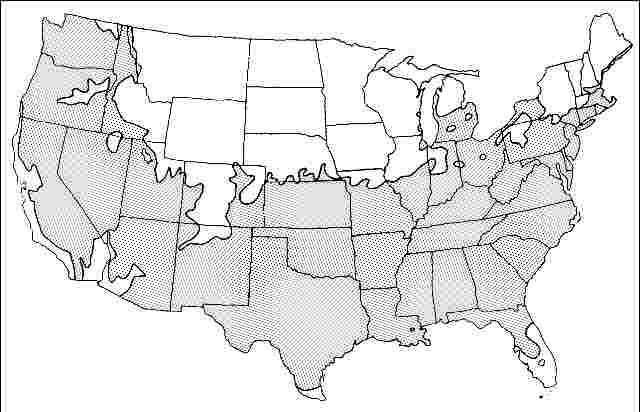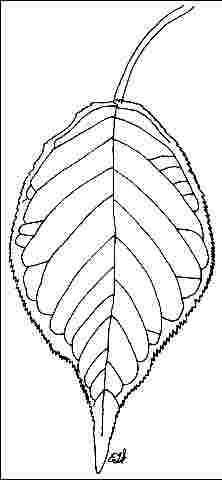Introduction
Kwanzan Cherry has double-pink, very attractive flowers and is usually purchased and planted for this reason. The upright-spreading form, reaching 15 to 25 feet tall, is quite attractive in many locations including near a patio or as a specimen away from lawn grass competition. The tree is glorious in flower and has been planted along with Yoshino Cherry in Washington, D.C., for the annual Cherry Blossom Festival. Kwanzan Cherry has good yellow fall color, does not bear fruit, but is troubled with pests. It prefers full sun, is intolerant of poor drainage, and is easily transplanted. However, useful life of the species is limited to about 15 to 25 years for `Kwanzan', on a good site. But the tree is a joy during this short period and should be planted.

Credit: Ed Gilman
General Information
Scientific name: Prunus serrulata
Pronunciation: PROO-nus sair-yoo-LAY-tuh
Common name(s): Kwanzan Cherry
Family: Rosaceae
USDA hardiness zones: 5B through 9A (Fig. 2)
Origin: not native to North America
Invasive potential: little invasive potential
Uses: street without sidewalk; deck or patio; specimen; container or planter; trained as a standard; parking lot island < 100 sq ft; parking lot island 100-200 sq ft; parking lot island > 200 sq ft; tree lawn 3-4 feet wide; tree lawn 4-6 feet wide; tree lawn > 6 ft wide; highway median; Bonsai
Availability: not native to North America

Description
Height: 15 to 25 feet
Spread: 15 to 25 feet
Crown uniformity: symmetrical
Crown shape: vase, upright/erect
Crown density: moderate
Growth rate: moderate
Texture: medium
Foliage
Leaf arrangement: alternate (Fig. 3)
Leaf type: simple
Leaf margin: serrate
Leaf shape: ovate, lanceolate
Leaf venation: pinnate, brachidodrome
Leaf type and persistence: deciduous
Leaf blade length: 2 to 4 inches, 4 to 8 inches
Leaf color: green
Fall color: yellow, orange, copper
Fall characteristic: showy

Flower
Flower color: pink
Flower characteristics: very showy
Fruit
Fruit shape: round
Fruit length: unknown
Fruit covering: fleshy
Fruit color: unknown
Fruit characteristics: does not attract wildlife; not showy; fruit/leaves not a litter problem
Trunk and Branches
Trunk/bark/branches: branches don't droop; showy; typically one trunk; thorns
Pruning requirement: little required
Breakage: resistant
Current year twig color: brown
Current year twig thickness: medium
Wood specific gravity: unknown
Culture
Light requirement: full sun
Soil tolerances: clay; sand; loam; acidic; alkaline; well-drained; occasionally wet
Drought tolerance: moderate
Aerosol salt tolerance: moderate
Other
Roots: not a problem
Winter interest: no
Outstanding tree: yes
Ozone sensitivity: unknown
Verticillium wilt susceptibility: susceptible
Pest resistance: sensitive to pests/diseases
Use and Management
Neither stress-tolerant or highly drought-tolerant, Kwanzan Cherry should be located on a site with loose soil and plenty of moisture. Not for an urban parking lot or exposed street tree planting where borers and other problems normally attack. It has some tolerance to salt, and tolerates clay if well-drained.
There are many other cultivars of Oriental Cherry but few are readily available. Some which may be locally available include: `Amanogawa'(`Erecta') - semi-double, light pink, fragrant flowers, narrow columnar habit, about 20 feet tall; `Fugenzo'(`James H. Veitch', `Kofugen') - spreading habit, flowers 2.5 inches across, rose pink fading to light pink, double, `Kofugen' sometimes described as having deeper color; `Shirofugen' - rapid growth rate, young foliage bronze later turning green, flowers double, 2.5 inches across, pink fading to white; `Shirotae'(`Mt. Fuji', `Kojima') - flowers double to semi-double, white, ruffled, about 2.5 inches across; `Shogetsu' - tree 15 feet tall, broad and flat-topped, flowers double, pale pink, center may be white, can be two inches across; `Ukon' - young foliage bronze, flowers pale yellow, semi-double.
Pests
Aphids cause distortion of new growth, deposits of honeydew, and sooty mold.
Borers attack flowering cherries. Keep trees healthy with regular fertilizer applications, and irrigation during drought.
Scales of several types infest cherries. Horticultural oil can be used to help control overwintering stages.
Spider mites cause yellowing or stippling but they are very difficult to see. They are usually noticed after leaves begin showing severe symptoms.
Tent caterpillars make large webbed nests in trees then eat the foliage. One defoliation may not be serious and small nests can be pruned out and destroyed. Use Bacillus thuringiensis when the insects are first seen and are still small.
Diseases
A bacterium causes leaf spot and twig cankers on cherry. Small, reddish spots dry, and drop out, giving a shot holed appearance. Defoliation can be severe when conditions favor disease development. Fertilize infected trees and prune out infected branches.
Black knot causes black swellings or galls on the branches. Branches with galls are pruned out.
Powdery mildew causes a white coating on the leaves, but control is seldom, if ever, warranted.
